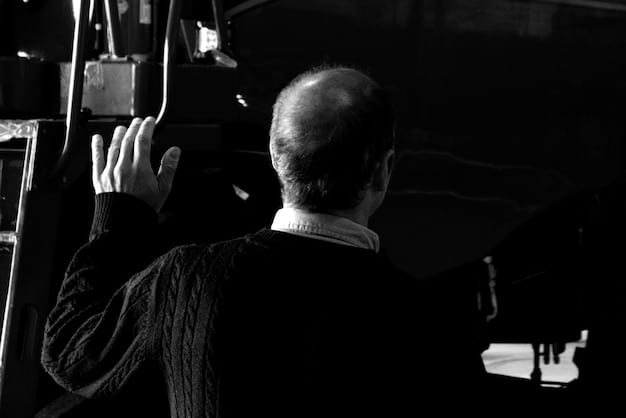National Film Archive Celebrates Brazilian Film History with Restored Classic

The National Film Archive of Brazil proudly unveils a newly restored classic Brazilian film, marking 50 years of cinematic history and offering a fresh perspective on the nation’s rich cultural heritage.
The National Film Archive is excited to announce the unveiling of a newly restored classic Brazilian film, celebrating 50 years of cinematic history. This event marks a significant milestone in preserving Brazil’s cultural heritage and making it accessible to new generations.
National Film Archive: Preserving Brazilian Cinema
The National Film Archive plays a crucial role in preserving Brazil’s cinematic history for future generations. Understanding the archive’s origins, mission, and preservation methods provides context to the significance of this restoration project.
The National Film Archive of Brazil, known as the Cinemateca Brasileira, was founded in 1940. Its primary mission is to collect, preserve, and disseminate Brazil’s audiovisual heritage. Over the decades, it has become the largest film archive in South America, housing an extensive collection of films, documentaries, newsreels, and other audiovisual materials.
The Importance of Film Preservation
Film preservation is vital for several reasons. It ensures that cultural and historical documents are not lost to time, allowing future generations to understand and appreciate the past.
- Cultural Identity: Films often reflect the cultural values, beliefs, and social norms of a particular time and place. Preserving these films helps maintain a sense of national identity.
- Historical Record: Films can serve as valuable historical records, providing insights into past events, lifestyles, and social conditions.
- Artistic Value: Many films are considered works of art. Preserving them ensures that their artistic merit is not lost and that future artists can learn from them.
The Cinemateca Brasileira employs various preservation techniques to ensure the longevity of its collection. These include:
- Physical Preservation: Storing films in climate-controlled environments to prevent degradation.
- Digital Restoration: Digitizing films to create high-quality copies that can be easily accessed and shared.
- Chemical Treatment: Applying chemical treatments to films to stabilize their physical condition and prevent further decay.
The restoration of this classic Brazilian film is a testament to the National Film Archive’s dedication to preserving Brazil’s cinematic heritage. It highlights the importance of their work in safeguarding cultural identity and historical records for future generations. The meticulous efforts ensure that the film can be enjoyed in its original glory, providing a window into Brazil’s past.
Celebrating 50 Years of Cinematic History
This newly restored film marks a significant milestone, celebrating 50 years since its original release. Delving into why this particular film was chosen for restoration and what impact it had on Brazilian cinema provides a deeper appreciation for its significance.
The film selected for restoration holds a special place in Brazilian cinematic history. When originally released, it captivated audiences with its compelling storyline, memorable characters, and innovative filmmaking techniques.
Reasons for Choosing this Film
Several factors contributed to the decision to restore this particular film:
- Cultural Significance: The film reflects important aspects of Brazilian culture, addressing social issues and portraying the country’s unique identity.
- Artistic Merit: Known for its innovative cinematography, storytelling, and acting performances.
- Popular Appeal: Remained popular with audiences over the years, earning a dedicated following and critical acclaim.
This classic Brazilian film left an indelible mark on Brazilian cinema. When it was first released, it set a new standard for filmmaking in the country, inspiring future generations of directors, actors, and technicians. Its success also helped to raise the profile of Brazilian cinema internationally, paving the way for other Brazilian films to gain recognition and acclaim.
The film’s influence extends beyond the realm of cinema. Its themes and messages resonated with audiences, sparking conversations about social issues. The restoration is not just about preserving a film; it’s about preserving a piece of Brazilian cultural and historical identity. By restoring this film, the National Film Archive ensures that its legacy will continue to inspire and influence future generations.

The Restoration Process: A Labor of Love
Restoring a film is a complex and time-consuming process that requires specialized knowledge and state-of-the-art equipment. Understanding the steps involved in restoring this classic Brazilian film will highlight the dedication and expertise required.
The restoration process began with a thorough assessment of the film’s condition. The original film reels were carefully inspected to identify any damage, such as scratches, tears, or discoloration.
Steps Involved in the Restoration Process
- Digital Scanning: The original film reels were scanned using high-resolution scanners to create digital copies.
- Image Cleaning: Digital copies were then cleaned to remove scratches, dust, and other imperfections.
- Color Correction: Technicians worked to restore the film’s original colors, ensuring that the final product accurately reflects the director’s vision.
Digital restoration techniques played a vital role in bringing this classic Brazilian film back to life. Advanced software and hardware were used to enhance image quality, remove unwanted artifacts, and improve overall clarity.
Throughout the restoration process, the team was committed to preserving the film’s original aesthetic, ensuring that the restored version remained true to the director’s vision. This involved careful collaboration between film historians, archivists, and restoration specialists to make informed decisions about how to address specific issues while preserving the film’s artistic integrity. The team’s dedication has resulted in a restored version that honors the film’s legacy while allowing audiences to experience it in the best possible quality.
Impact on Brazilian Culture and Society
The themes explored in the newly restored film are relevant to Brazilian culture and society. Examining how the film reflects and influences Brazilian identity provides a deeper understanding of its cultural significance.
This classic Brazilian film explores themes that are deeply rooted in Brazilian culture and society. When it was originally released, it sparked conversations about social issues.
Themes Explored in the Film
Some of the prominent themes explored in the film include:
- Social Inequality: The film portrays the disparities between different social classes and the struggles faced by marginalized communities.
- Political Corruption: The film sheds light on corruption within the government and its impact on the lives of ordinary citizens.
- Cultural Identity: The film celebrates unique aspects of Brazilian culture, such as music, dance, and traditions.
The film has had a lasting impact on Brazilian identity, influencing the way Brazilians see themselves and their country. Its success helped to promote a sense of national pride and cultural awareness, inspiring other artists and filmmakers to explore similar themes in their own work.
Furthermore, it contributed to a broader cultural movement that sought to challenge existing power structures and promote social justice. The film’s enduring legacy is a testament to its ability to resonate with audiences and spark meaningful conversations about the issues that matter most to Brazilian society. The restoration ensures that these conversations will continue for generations to come, allowing future audiences to engage with the film’s themes and messages in new and meaningful ways.

The Future of Film Preservation in Brazil
The unveiling of this restored film raises important questions about the future of film preservation in Brazil. Discussing the challenges and opportunities facing the National Film Archive provides insight into the ongoing efforts to safeguard Brazil’s cinematic heritage.
The National Film Archive faces numerous challenges in its efforts to preserve Brazil’s cinematic heritage. These include:
Challenges and Opportunities
- Funding: Securing adequate funding for preservation projects is a constant challenge.
- Technology: Keeping up with technological advancements in film preservation is essential.
- Accessibility: Ensuring that preserved films are accessible to the public.
Collaborations between the National Film Archive and other organizations are vital for the future of film preservation in Brazil. By working together, these organizations can share resources, expertise, and best practices, maximizing their collective impact. International partnerships can also play a crucial role, providing access to funding, technology, and training programs.
The ongoing efforts represent a commitment to preserving Brazil’s cinematic identity for future generations. By addressing the challenges and seizing the opportunities that lie ahead, the National Film Archive can ensure that Brazil’s rich film history continues to inspire and enrich lives for many years to come. The restoration of this classic film serves as a reminder of the importance of this work and the value of preserving cultural heritage.
How to Experience the Restored Film
For those eager to experience the newly restored classic Brazilian film, several avenues are available. Sharing information on screenings, distribution methods, and online platforms ensures that the film reaches a wide audience.
There are several ways to experience the newly restored classic Brazilian film. To begin, film screenings are being organized at various locations, including:
- Film Festivals: The restored film may be showcased at local and international film festivals, offering a chance to see it on the big screen.
- Special Events: The National Film Archive may host special events, such as premiere screenings.
- Art House Theaters: Select art house theaters may feature the restored film as part of their programming.
Information about upcoming screenings and events can be found on the National Film Archive’s website and social media channels.
Finally, the National Film Archive’s role in promoting the film’s accessibility cannot be overstated. By organizing screenings, collaborating with distributors, and leveraging online platforms, the archive ensures that the restored film reaches a wide audience. The archive’s efforts ensure that the film is available to anyone interested in experiencing this piece of Brazilian cinematic history.
| Key Point | Brief Description |
|---|---|
| 🎥 Film Selection | Chosen for cultural and artistic significance. |
| 🎞️ Restoration Process | Digital scanning, image cleaning, and color correction. |
| 🌍 Cultural Impact | Explores social issues and reflects Brazilian identity. |
| 🏛️ Archive’s Role | Preserves and promotes Brazilian cinematic heritage. |
What makes this film historically significant?
▼
This film was chosen for its cultural significance, artistic merit, and lasting impact on Brazilian cinema. It reflects important aspects of Brazilian culture and has remained popular with audiences over the years.
▼
The main challenges include securing adequate funding, keeping up with technological advancements, and ensuring that preserved films are accessible to the public. Collaborations and international partnerships are crucial.
▼
You can watch the restored film at film festivals, special events hosted by the National Film Archive, and select art house theaters. Keep an eye on the archive’s website and social media for announcements.
▼
Digital restoration involves scanning film reels and uses software to remove imperfections. It is important because it ensures that the original colors are restored, and overall image quality is improved.
▼
The National Film Archive collects, preserves, and shares Brazil’s audiovisual heritage. It employs various preservation techniques and collaborates with other organizations to ensure the longevity of its collection.
Conclusion
The unveiling of this newly restored classic Brazilian film is a momentous occasion, celebrating 50 years of cinematic history and the tireless efforts of the National Film Archive. It serves as a reminder of the importance of preserving cultural heritage and the power of cinema to reflect and influence society. Through careful restoration and promotion, this film is now accessible to a new generation, ensuring its legacy will endure for years to come.




